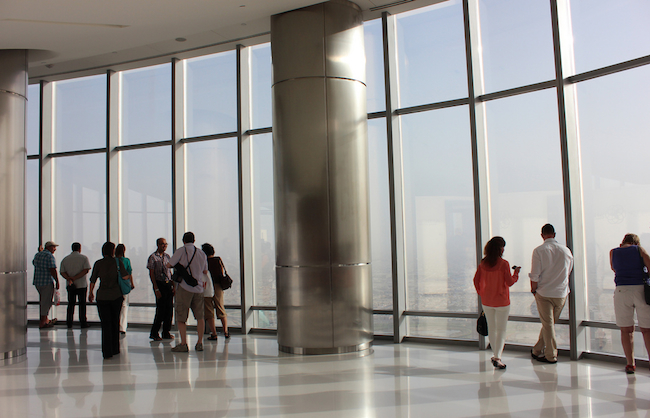The Arabian music and lights are soft and atmospheric, conjuring up wild desert landscapes in my imagination: falcons frozen on invisible air currents, the loping gate of a camel transporting exotic spices in the blazing heat of late summer, rolling rust-red dunes forming an undulating sea of sand, a Bedouin tent shimmering mirage-like in the softening colours of sunset. The music falls squarely in the category of elevator music, appropriately playing in a parcel-sized space that doesn’t seem to be moving, despite the digital numbers on the display screens that are hopping and skipping playfully over entire floors, teasing and tormenting my eyes. Before long, the elevator that makes the longest travel distance in the world, and travels at a speed of up to 10 metres per second, effortlessly glides to a graceful stop. Polished steel doors slide open with what sounds like a barely audible sigh. Twelve people step out on level 124.
It has taken less than a minute to reach our destination, despite the sludge-like queue that imprisoned us at the bottom for over an hour. Only a couple of handfuls of the 28, 261 glass panels that clad this marvel of engineering shield me from empty space and certain death. The sheer glass walls inexplicably negate my usual fear of heights, and I am irresistibly drawn to them. Pressing my palms and nose against the cold glass, I try to imagine the ant-like bodies of the 12,000 workers that scurried around during the height of its six year construction. I feel small and insignificant. A coward cocooned by a glass case. I gaze out towards an imagined city built out of Lego blocks. Nothing feels quite real from this height. Thin strips of black ribbon pretend to be roads, azure and turquoise water give the impression of a tropical paradise, and verdant clumps of trees masquerade as forests, in what is essentially a bleak stretch of dry land.
On the outdoor viewing deck a blast of fresh air awakens my sense of survival. I feel like I’m floating in space, but the slow descent of the sun distracts me momentarily. As it gracefully dips into the Arabian Gulf it leaves artist’s brushstrokes in shades of orange, pink and gold on a canvas painted with wispy clouds. I stare at the man-made islands that swim in tepid water.

The Burj Khalifa, dwarfing all other high rises in downtown Dubai, glistens in the last rays of the setting sun. Pools of golden sunshine get trapped in the seductive curves of the glass exterior before slowly seeping into the understated, yet, luxurious interior of the Armani Hotel and Residences where sophisticated guests look out towards a sea of lights that gradually awakens to sparkle in tints of silver, copper and gold.
At the foot of the tower the musical fountains start to dance to what could well be an echo of the elevator music – it is slow, seductive and utterly captivating. Streams of pressurised water mingle with illuminating light to twist, twirl, skip, explode and bow to the command of an invisible choreographer. From up above it sparkles and bends into alluring shapes that obey the rhythm of music too distant to discern; leaving me charmed. My hands that clutch the insignificant camera, dangling in the empty space where I’ve pushed it through a gap between two glass panels, struggle to stay steady, as I desperately aim to capture this fleeting, magical moment.
Later, standing at the foot of this majestic tower, I can almost believe the urban legend that it can be seen from space. Hot, humid Dubai is for most of the year enveloped in humidity or dust, and even if the claim that it can be seen from ninety-five kilometres away is true, it seldom is. The strong winds that regularly sweep across the once empty salt flats now sway this soaring 828 metre tower like a reed in a summer’s breeze.

The lush, landscaped gardens at the bottom intertwine with concrete and water, creating intricate nature-based imagery so typical in Islamic design. The reflecting pools catch the shadowy image of the tower that gazes down like Narcissus at its own reflection. It stands as a symbol for man’s ego and search for power that is forever striving to create bigger, better and taller.
The Burj Khalifa towers over a city unlike any other in the Islamic world. It is luring throngs of tourists to promises of sun, sea and shopping; filling oil-deprived Dubai’s coffers with cold, hard cash. It is a city that sells dreams: both possible and impossible.
Jolandi Steven blogs at Dreaming in Arabic about life in the United Arab Emirates where she currently lives.
[photography by Jolandi Steven and PlannedCity via flickr common license.

